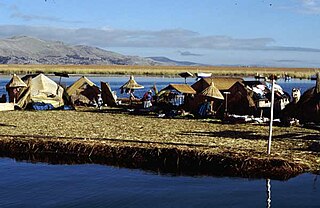| Look up floating island in Wiktionary, the free dictionary. |
A floating island is a mass of floating aquatic plants, mud, and peat.

A floating island is a mass of floating aquatic plants, mud, and peat ranging in thickness from several centimetres to a few metres. Floating islands are a common natural phenomenon that are found in many parts of the world. They exist less commonly as an artificial phenomenon. Floating islands are generally found on marshlands, lakes, and similar wetland locations, and can be many hectares in size.
Floating island may also refer to:
- Very large floating structure, a real or fictional artificial floating "island"
- Floating island (fiction), the concept in fiction
- Floating island (dessert), a French dessert
- The Floating Island (Head novel), a 1673 novel by Richard Head
- Floating Island (novel), a 1930 novel by Anne Parrish
- The Floating Island (Haydon novel), a 2006 novel by Elizabeth Haydon
- The "Floating Island" or "Angel Island," a recurring location in the Sonic the Hedgehog series
- Floating islands (Bingöl), mass of floating aquatic plants in the form of islands on a lake in Bingöl Province, Turkey
- Floating Islands (album), an album by Lotte Anker

Very large floating structures (VLFSs) or very large floating platforms (VLFPs) are manmade islands, which may be constructed to create floating airports, bridges, breakwaters, piers and docks, storage facilities, wind and solar power plants, for military purposes, to create industrial space, emergency bases, entertainment facilities, recreation parks, mobile offshore structures and even for habitation. Currently, several different concepts have been proposed for building floating cities or huge living complexes. Some units have been constructed and are presently in operation.

A floating island is a dessert of French origin, consisting of meringue floating on crème anglaise. The meringues are prepared from whipped egg whites, sugar, and vanilla extract then quickly poached. The crème anglaise is prepared with the egg yolks, vanilla, and hot milk, briefly cooked.
The Floating Island is a 1673 satirical novel by Richard Head, though he published it under the name of Frank Careless. It is a parody of stories of adventure, describing the travels of captain Robert Owe-much through distant lands, which reference various neighbourhoods of London.
| This disambiguation page lists articles associated with the title Floating island. If an internal link led you here, you may wish to change the link to point directly to the intended article. |








